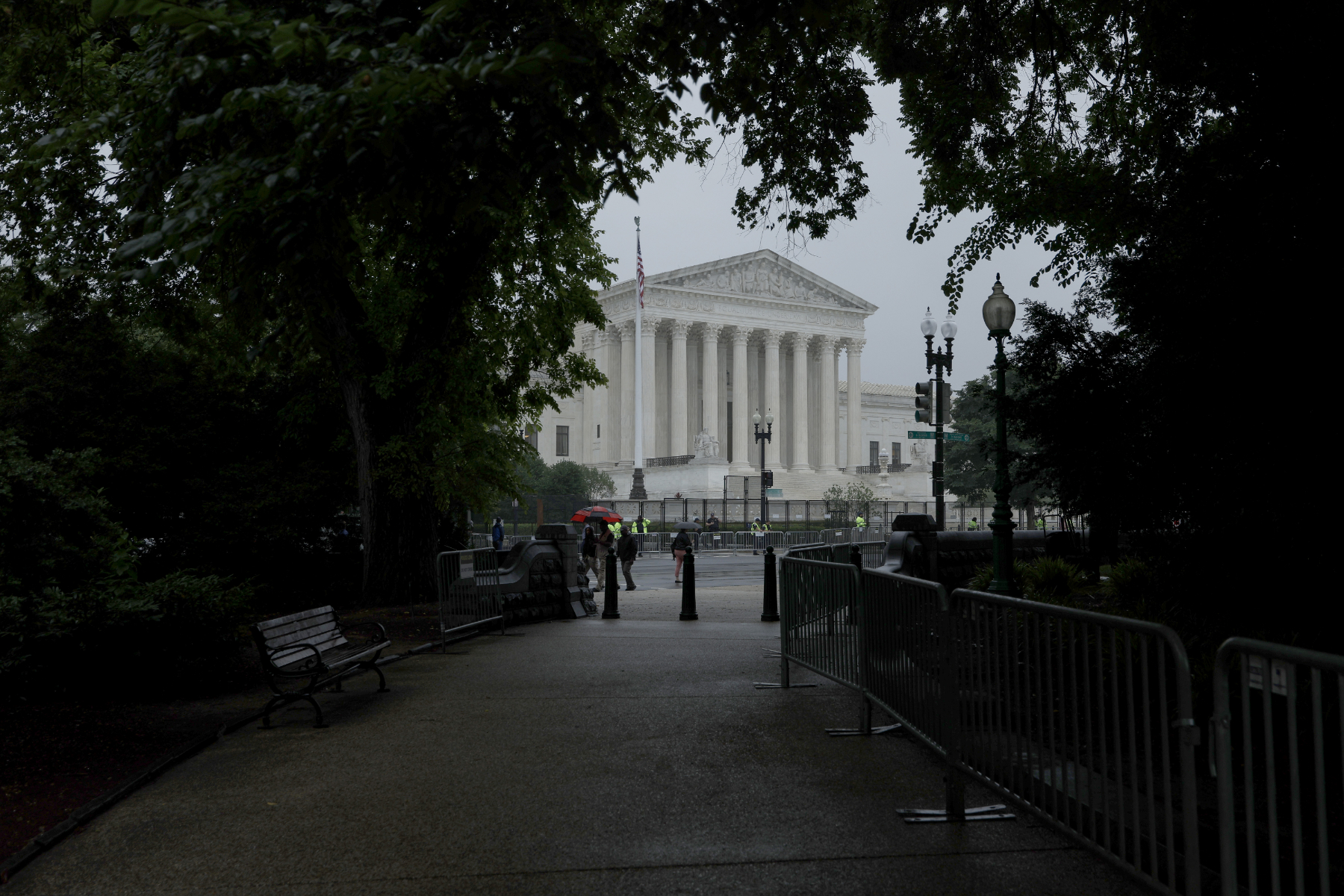On November 7, the Supreme Court will hear oral arguments in the case of United States v. Rahimi, likely determining the constitutionality of a federal law that bars those with a standing domestic violence restraining order from owning firearms. Their decision could also shape the future of not only the ability to enact any restrictions on the Second Amendment but the extent to which the judicial philosophy of originalism will be used to define constitutional rights.
Here’s what you need to know about this case, why the court is hearing it now, and how originalism could be used for determining the scope of Second Amendment rights.
What are the facts of this case?
In 2019, Zackey Rahimi physically assaulted his girlfriend in a parking lot in Texas. He then told her that if she reported the incident to law enforcement, he would shoot her.
The girlfriend ultimately petitioned a Texas state civil court to grant her a domestic violence restraining order.
Rahimi later threatened a different woman with a gun and was then charged with assault with a deadly weapon. He also went on to shoot off guns in public on five more occasions, including shooting an AR-15 assault rifle into the home of someone who had once bought drugs from him and shooting into the air at a fast food restaurant when a friend’s credit card was declined. These incidents led to a legal police search of Rahimi’s home, which resulted in the discovery of multiple firearms and rounds of ammunition.
Under a 1994 federal law, anyone with a domestic violence restraining order actively in place against them is barred from possessing or purchasing firearms. Rahimi was then charged with violating that law.
Why is the court hearing this case now?
In June 2022, the Supreme Court ruled in New York State Rifle & Pistol Association v. Bruen that New York state’s law requiring a permit for carrying concealed weapons in public places was unconstitutional. The majority decision, written by Justice Clarence Thomas, said an originalist interpretation of the Constitution required that any restriction on firearms must be “consistent with the Nation’s historical tradition” — meaning that it must have a point of reference rooted in the time of the Constitution’s signing. Furthermore, Thomas wrote, this new precedent superseded the long-standing practice of allowing the government to weigh its interest in public safety against the possibility of imposing a limitation on Second Amendment rights. As a result of this ruling, the U.S. Court of Appeals for the 5th Circuit reversed its original conviction of Rahimi, saying that in interpreting the Supreme Court’s ruling in Bruen, a domestic violence restraining order could not be used to justify restricting Rahimi’s right to bear arms.
In agreeing to hear this case, the Supreme Court stands to decide whether the 5th Circuit’s reversal was correct, including whether the federal government — and, potentially, state and local governments as well — can restrict a person’s Second Amendment rights based on a civil protective order and, more broadly, whether any kind of restrictions on Second Amendment rights can be enforced post-Bruen.
-
More like this:
What is a domestic violence restraining order?
A domestic violence restraining order is a protective measure issued by a civil court. While the specifications of what these orders do can vary by state, they generally require a person accused of abuse to stop harming or threatening a victim; stay physically away from a victim’s home, workplace and school; and cease all communication with a victim. To receive such an order, an accuser must petition a civil judge and provide evidence. Civil courts’ evidentiary standard is a “preponderance of evidence,” not “beyond a reasonable doubt” as in criminal courts. If a judge finds that a preponderance of evidence shows proof of abuse, stalking, harassment or any other form of domestic or intimate partner violence, they will grant the accuser a domestic violence restraining order.
Many barriers exist to getting such an order, which are disproportionately granted to women, said Sabrina Talukder, director of the Women’s Initiative at the liberal Center for American Progress (CAP). Talukder told The 19th that to even petition for such an order, a survivor must be able to freely leave their house, safely travel to court and deal with the consequences of filing it — which often include having to leave behind home and financial security and going into some measure of hiding. These barriers are even higher for survivors who have children.
“This is the best-case scenario of someone who speaks English, of someone who understands that there are options available to them, someone who feels comfortable with the criminal and civil law enforcement systems enough that they feel like they can go into court and not considered to be the perpetrator, that they won’t be arrested for walking into court because they have a warrant somewhere or a prior criminal history,” Talukder said.
Domestic violence restraining orders are not available to minors.
What is the federal law in question, and how is it enforced?
Title 18, 922 (g)8 of the federal code prohibits the possession or receipt of firearms by those subject to domestic violence protection orders.
Talukder explained that the enforcement of this law, which is the one in question in Rahimi, really depends on the implementation of state, city, and local laws.
“There isn’t a mechanism to ensure that someone who is under this order is dispossessed of their firearms,” Talukder said.
Much of the regulation of gun possession is impacted by state laws on gun access and ownership. As a result, the federal law is often at play only when someone is found to be in possession of a gun because of an unrelated legal issue.

How does restricting access to firearms affect domestic abuse?
“There is a deadly intersection between intimate partner violence and guns,” said Diana Kasdan, the director of judicial strategy at the Center for Reproductive Rights. “And [the federal law at the center of Rahimi] is one that has been shown can reduce the risk of homicide and harm for pregnant and postpartum people.”
Restricting access to guns for those who have been determined by a court to have committed domestic violence has been shown to dramatically reduce homicide rates — so much so, that beyond the federal law in question, many states have taken things further by passing what are known as extreme risk laws, sometimes called “red flag laws.”
Twenty-one states and the District of Columbia have passed extreme risk laws that allow a person to petition to have an individual’s firearms confiscated. A petitioner must present evidence to a judge about the potential threat posed by the person, and the judge must determine that the evidence presented meets the standard for temporary confiscation. “It’s not a solution for everything, but it is a reasonable measure the government can take to protect the lives and safety and health of all people,” Kasdan said — including those in domestic violence situations, and especially pregnant people who are often particularly vulnerable.
Talukder noted that there has been a documented 13 percent reduction in intimate partner homicides in those states where protective orders cover dating partners and not just spouses. Likewise, there is also a 13 percent reduction in intimate partner homicides in states whose laws cover temporary and not just permanent protective orders. Currently, 20 states include temporary protective orders in their dispossession policies: Arizona, California, Hawaii, Illinois, Maine, Massachusetts, Michigan, Montana, Nebraska, New Hampshire, New Jersey, New York, North Carolina, North Dakota, Pennsylvania, Texas, Utah, Virginia, Washington and West Virginia.
Everytown for Gun Safety, which advocates for gun safety regulations, is among the groups that filed an amicus — or “friend of the court” — brief on behalf of the U.S. government. Janet Carter, the senior director of issues and appeals at Everytown, said that its brief, like many others, emphasizes that the danger from guns is not just the potential of physical harm but also the toll they take on domestic violence victims when used for intimidation. This quiet use of guns as an intimidating force is not only “a serious part of gun violence, but also of coercive control within abusive relationships,” Carter said.
What is the defense arguing in this case?
The defense is asking the Supreme Court to affirm the 5th Circuit’s reversal, arguing that federal appeals court appropriately applied the standards set by the Bruen ruling. They also state that the federal law in question is unconstitutional for five reasons: First, because it serves as a total ban on firearms and ammunition, including in the home; second, because the statute carries criminal penalties including up to 15 years of federal prison time; third, that it applies to U.S. citizens who otherwise retain their other civic rights; fourth, that the ban is not triggered by a criminal conviction, but a civil order; and fifth, that as a federal ban, it incorrectly supersedes states’ rights.
In an amicus brief filed for the defense by the National Rifle Association (NRA), the gun rights advocacy group also argues that domestic violence restraining orders are inherently unconstitutional and that any accusations of domestic violence should be tried in criminal court and come coupled with a conviction. Restraining orders, the NRA argues, are an ineffective way to change the behavior of a person willing to break the law and thus should also be ended as a practice.
Who stands to be most impacted by the Rahimi ruling?
Women, LGBTQ+ people and those from marginalized backgrounds are disproportionately impacted by domestic violence and thus likewise stand to also be those most impacted should the court rule in favor of the defense. Women in the United States are 11 times more likely to be killed with a firearm than women in other high-income countries, female intimate partners are more likely to be killed with a gun than all other means combined, and the presence of a gun increases the risk of homicide for women in domestic violence situations by 500 percent. One in 4 women in the United States has been the victim of severe domestic violence injury in her lifetime, and 1 in 3 women in the United States has experienced rape, stalking or domestic violence.
Kasdan specifically emphasized the deep connection between intimate partner violence, gun violence and maternal mortality. “Homicide is the leading cause of death for those who are pregnant or postpartum, and the majority of these deaths involve firearms,” Kasdan said.
The Center for Reproductive Rights filed an amicus brief outlining the relationship between gun violence, domestic violence and maternal mortality and pressing the court to consider the ways in which the lives of pregnant people will be at risk should the 5th Circuit’s ruling stand. In 2020, Kasdan said, 81 percent of all pregnancy-related homicides involved guns.
“A pregnancy really does become a trigger for an increase in violence and abuse in relationships,” Kasdan explained, pointing to the decision of whether to continue the pregnancy, the economic stress of a pregnancy and the general stress of parenting as factors that can often trigger intimate partner abuse.
Kasdan told The 19th that this new litmus test of seeking a historical counterpoint from the time of America’s founding, as the Supreme Court did in the Bruen decision, could prove particularly dangerous in cases like Rahimi, where those disproportionately impacted by a lack of regulation are women. “At the time when guns were being regulated when the Second Amendment was written, many people — and women in particular — were not part of the body politic.” Back then, she said, “women were a kind of property, subject to the men of their households and a certain degree of control was expected.”









